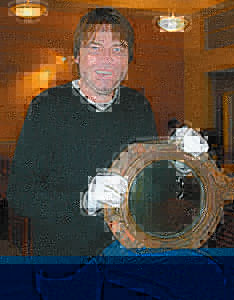Titanic explorer talks about the treasure found on the bottom of the sea
Titanic expert Mark Lach spoke at
CEU on Thursday, October 22 in the
alumni room as part of the exhibit at
the Utah Museum of Natural History,
at the Annex, ZCMI Center in Salt
Lake City. He also spoke to Mont
Harmon and Helper junior high
schools.
Lach spoke of the tragedy of Titanic
and of items recovered from the
ocean floor surrounding it. Contrary
to what one might believe, resources
are not allowed to remove items from
the ship itself, partly to preserve the
sanctity of the final resting places of
the people aboard the Titanic who did
not make it off the ship alive. All

This archived article was written by: Heather Myers Kimberlee Ritchie
Titanic expert Mark Lach spoke at
CEU on Thursday, October 22 in the
alumni room as part of the exhibit at
the Utah Museum of Natural History,
at the Annex, ZCMI Center in Salt
Lake City. He also spoke to Mont
Harmon and Helper junior high
schools.
Lach spoke of the tragedy of Titanic
and of items recovered from the
ocean floor surrounding it. Contrary
to what one might believe, resources
are not allowed to remove items from
the ship itself, partly to preserve the
sanctity of the final resting places of
the people aboard the Titanic who did
not make it off the ship alive. All
articles recovered from the ship are
located in the surrounding area of the
ship commonly known as the debris
field.
He also spoke of his own experience
aboard a submersible to visit the
great ship. June 2004, Lach went on
a six-week expedition to the wreck
site. “Being in the blackness for the
two-and-a-half hours before seeing
the Titanic was like the moment of
anticipation when the lights go down
in the theatre,” he said.
Lach works for a company called
RMS Titanic. Although the ship lies
in international waters, all of the artifacts
that are recovered become property
of this company due a U.S Supreme
Court decision. These artifacts
are on display in three different exhibitions
around the world. They are
Manchester, England; Philadelphia,
Penn., and Salt Lake City, Utah. Since
1991, the exhibit has been shown in
seven countries and 20 states.
These exhibitions include recreations
of the rooms aboard the Titanic
as well as artifacts brought up from
the ocean floor on retrieval expeditions.
Some of these artifacts are
located in water-filled containers, due
to the fact that the salt content would
cause the items to disintegrate if they
were exposed to the air.
Some of the best preserved artifacts
are found in treated leather cases,
due to the fact that the chemicals used
in the tanning process repel microoranisms that would otherwise eat away
at the leather. Lach brought with him
a $10 bill printed in Colorado that was
found preserved in a leather carrying
case.
Lach has had a chance to meet
with one of the two surviving passengers
of Titanic. 92-year-old Melvina
Dean was the youngest passenger
aboard when the ship went down.
She was seven months old and was
handed into a lifeboat by her father
who was among those who did not
survive. Lach showed her around one
of the exhibits. Melvina grew up with
stories of Titanic and refuses to see
the movies because she has heard the
real stories from her mother, but gladly
visits exhibitions that have actual artifacts
recovered from the Titanic.
The Utah Museum of Natural History
wasn’t large enough for this exhibit,
so they ended up using space at
the ZCMI center located at 47 South
Main Street in downtown Salt Lake
City. The exhibit will be open until
January 8, 2005. Prices vary, but
CEU students can get $3 off of admission
price by picking up a coupon at
the information desks in the Jennifer
Leavitt Student Center.




